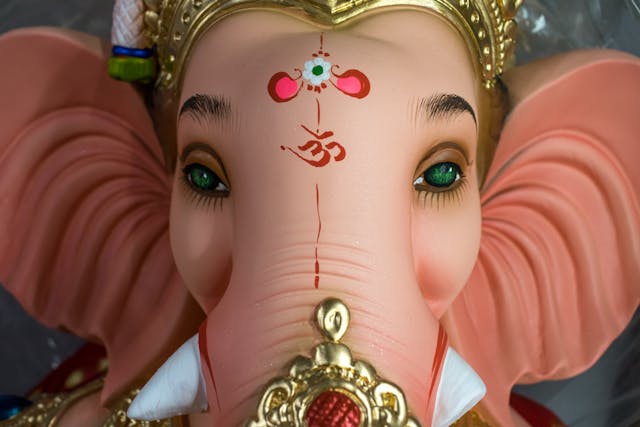The pooja room, a sanctuary of peace and reflection, deserves a colour palette that resonates with serenity and spirituality. Choosing the right hues can transform this space into a haven of tranquility, fostering a deeper connection with the divine. This article explores some inspiring pooja room colour combinations, helping you create a space that truly reflects your personal faith and style. And if you’re looking for expert guidance in designing your entire home, including your pooja room, consider connecting with a top-notch interior designer in Bangalore or even the best interior designer in Bangalore.
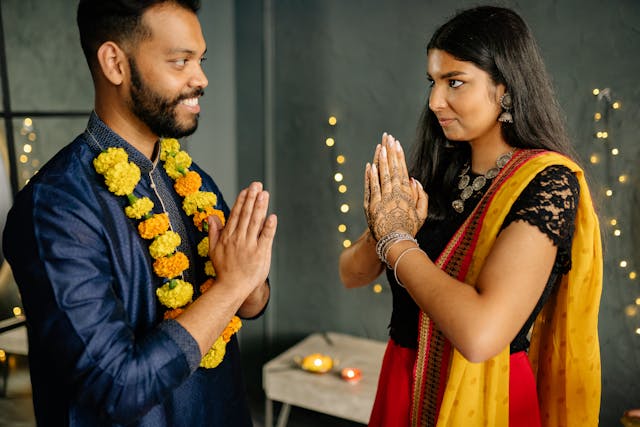
Understanding the Significance of Colour
Before diving into specific combinations, let’s touch upon the symbolism of colours in Indian tradition. While personal preferences play a crucial role, understanding the traditional meanings can help you make informed choices.
- White: Represents purity, peace, and knowledge. It’s a classic choice for pooja rooms, creating a sense of spaciousness and light.
- Yellow: Symbolizes auspiciousness, wisdom, and prosperity. It’s associated with positive energy and is often used in religious ceremonies.
- Orange/Saffron: Represents sacrifice, courage, and spirituality. It’s a vibrant and energizing colour that can add warmth to the space.
- Green: Symbolizes nature, growth, and healing. It brings a sense of freshness and tranquility.
- Blue: Represents divinity, calmness, and truth. Lighter shades of blue can create a peaceful atmosphere.
Inspiring Pooja Room Colour Combinations
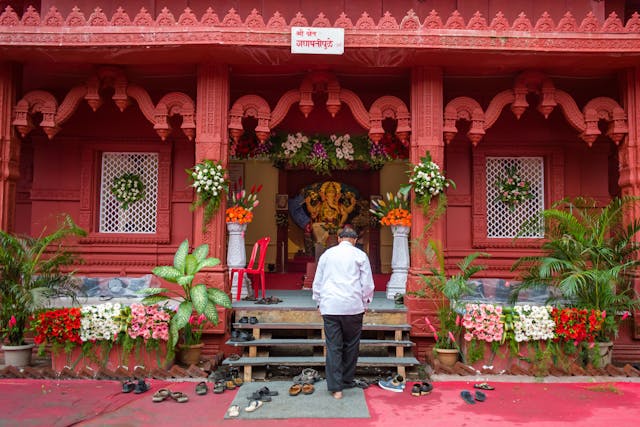
Now, let’s explore some captivating pooja room colour combinations that can transform your space:
- Classic & Serene: White and Gold. This timeless combination exudes elegance and purity. The white provides a clean canvas, while gold accents (in the form of embellishments, statues, or paint details) add a touch of opulence and divinity.
- Warm & Inviting: Saffron and Beige. This combination creates a warm and welcoming atmosphere. The saffron adds a vibrant touch, while the beige balances it with a sense of calmness.
- Tranquil & Peaceful: Light Blue and White. This combination evokes a sense of peace and tranquility. The light blue creates a serene backdrop, while the white enhances the sense of spaciousness.
- Natural & Earthy: Green and Brown. This combination brings the serenity of nature indoors. The green symbolizes growth and harmony, while the brown adds a grounding element.
- Modern & Minimalist: White and Grey. This combination is perfect for those who prefer a clean and contemporary aesthetic. The white creates a bright and airy space, while the grey adds a touch of sophistication.
- Vibrant & Auspicious: Yellow and Orange. This combination radiates positive energy and is ideal for creating a vibrant and auspicious atmosphere. Use these colours strategically, perhaps as accent walls or in the form of decorative elements.
- Elegance and Sophistication: Cream and Gold. A softer alternative to pure white, cream offers warmth while maintaining a sense of purity. Paired with gold accents, it creates a sophisticated and inviting space.
Tips for Choosing the Right Colours:
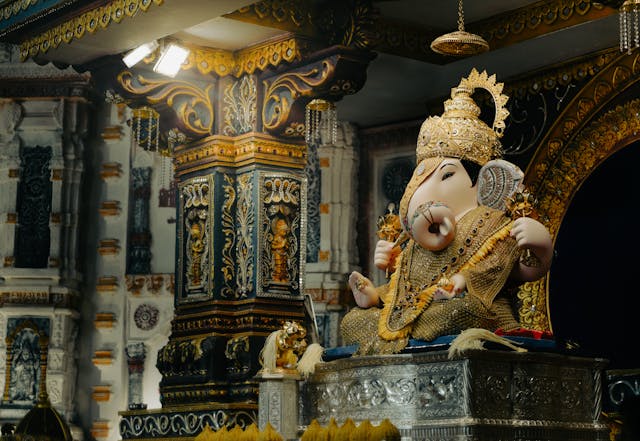
- Consider the size of your pooja room: Lighter colours can make a small room feel larger, while darker colours can add depth to a larger space.
- Think about the direction your pooja room faces: A north-facing room might benefit from warmer colours, while a south-facing room can handle cooler tones.
- Reflect on your personal preferences: Ultimately, the best colours for your pooja room are those that resonate with you and create a space where you feel at peace.
Seeking Professional Guidance:
If you’re feeling overwhelmed by the design process, don’t hesitate to seek professional help. A skilled interior designer in Bangalore, or even the best interior designer in Bangalore, can help you create a pooja room that is both beautiful and functional, seamlessly integrating your personal style with the principles of Vastu and design. They can provide expert advice on colour selection, material choices, and overall layout, ensuring that your pooja room becomes a true sanctuary within your home.
Creating a sacred space is a deeply personal journey. By carefully considering the pooja room colour combination and incorporating elements that resonate with your faith, you can create a haven of peace and tranquility that nurtures your spiritual well-being.
Let’s bring these pooja room colour combination ideas to life with some real-world examples:
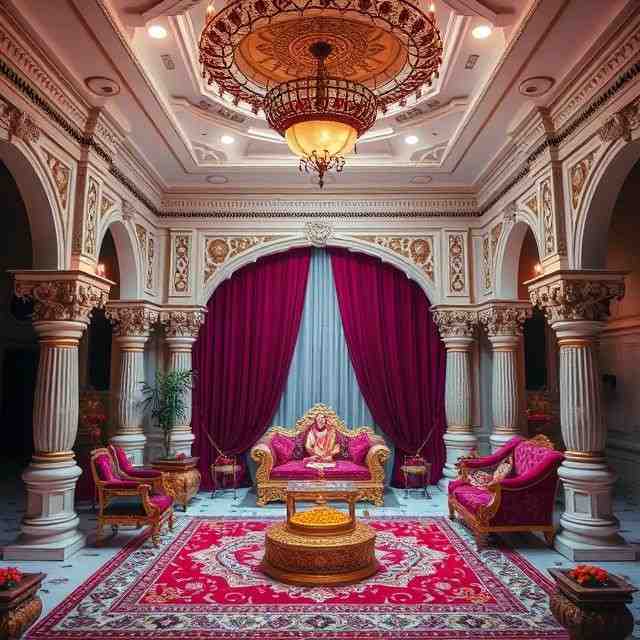
1. Classic & Serene: White and Gold
- Example: Imagine a small, dedicated pooja room within a Bangalore apartment. The walls are painted a crisp, off-white, almost bordering on cream, to soften the starkness. A beautifully carved wooden frame, finished in gold leaf, surrounds the deity’s niche. Small gold diya stands and a brass bell further accentuate the golden accents. The floor is polished white marble, reflecting the light and enhancing the sense of purity. A simple white cotton cloth serves as the altar covering. The overall effect is one of understated elegance and serene devotion.
2. Warm & Inviting: Saffron and Beige
- Example: Picture a pooja space integrated into a larger living room in a traditional Kerala home. One wall, serving as the backdrop for the deities, is painted a warm, but not overly bright, saffron. The remaining walls are a calming beige. A low, wooden platform painted in a slightly darker shade of beige serves as the altar. Small clay lamps in terracotta hues add to the earthy feel. The floor could be a warm-toned wooden laminate or even traditional terracotta tiles. The space feels inviting and grounded, perfect for family prayers.
3. Tranquil & Peaceful: Light Blue and White
- Example: Envision a modern pooja room in a high-rise apartment. The walls are a soft, sky blue, creating a sense of openness and tranquility. The ceiling is white, enhancing the feeling of spaciousness. A simple white marble statue of a deity is placed on a white pedestal. Sheer white curtains diffuse the natural light, adding to the serene atmosphere. The floor is a light-colored tile, perhaps a pale grey or a very light wood finish. The overall effect is calming and peaceful, ideal for meditation and reflection.
4. Natural & Earthy: Green and Brown
- Example: Imagine a pooja room in a farmhouse, overlooking a garden. One wall is painted a soothing sage green, reminiscent of the surrounding nature. The other walls are a warm, earthy brown, perhaps a light wood paneling or even a textured paint effect. A small, wooden altar sits against the green wall. Small potted plants, like a tulsi plant, are placed around the room, bringing the outdoors in. The floor could be a natural stone like slate or even a dark bamboo. The space feels connected to nature and promotes a sense of grounding.
5. Modern & Minimalist: White and Grey
- Example: Picture a contemporary pooja room in a minimalist apartment. The walls are a crisp, clean white. Accents of light grey are introduced through the flooring (perhaps polished concrete or light grey tiles) and a simple grey border around the deity’s niche. A sleek white shelf serves as the altar. A single, modern artwork depicting a spiritual symbol hangs on the wall. The space is uncluttered and serene, reflecting a modern approach to spirituality.
6. Vibrant & Auspicious: Yellow and Orange
- Example: Imagine a pooja room in a traditional Gujarati household. One wall is painted a vibrant, but not overpowering, yellow. Accents of orange are introduced through cushions, decorative elements, and perhaps a painted border. A beautifully carved wooden swing, painted in yellow and orange, is placed in the room. The floor is a traditional mosaic tile in warm hues. The space is filled with positive energy and radiates a sense of auspiciousness.
7. Elegance and Sophistication: Cream and Gold
- Example: Picture a pooja room in a large, luxurious home. The walls are a soft, creamy white, creating a warm and inviting atmosphere. Intricate gold detailing is incorporated into the ceiling design and the ornate frame surrounding the deity’s image. A plush cream-colored carpet adds to the luxurious feel. A beautifully crafted wooden altar, also with gold accents, is the focal point of the room. The space exudes elegance and sophistication, creating a sense of reverence and grandeur.
These are just a few examples, and the possibilities are endless. Remember to personalize your pooja room by incorporating elements that are meaningful to you and reflect your personal style and beliefs. These real-life examples should give you a starting point for creating your own divine haven.
Pooja Room Colour Combination FAQs
Here are some frequently asked questions about choosing the right colours for your pooja room:

General Colour Questions:
Q: Which colour is best for a pooja room?
A: There’s no single “best” colour. Traditional choices like white, yellow, and light blue are popular for their symbolic meanings (purity, auspiciousness, peace). However, personal preference plays a significant role. Choose colours that resonate with you and create a space where you feel at peace.
Q: Can I use dark colours in my pooja room?
A: While lighter colours are generally preferred, dark colours can be used strategically. For example, a dark wood altar against a light wall can create a beautiful focal point. Avoid using dark colours excessively, especially in small pooja rooms, as they can make the space feel cramped.
Q: What colours should I avoid in a pooja room?
A: While personal preferences are key, some believe that overly stimulating or aggressive colours (like bright red or very dark shades) might not be ideal for a space meant for peace and reflection. However, even these can be used as accents if they hold personal significance.
Q: How do I choose a colour combination for my pooja room?
A: Consider the size of your room, the direction it faces (north-facing rooms often benefit from warmer tones), and your personal preferences. Think about the overall atmosphere you want to create (serene, vibrant, traditional, modern). Experiment with colour swatches or online tools to visualize different combinations.
Q: Can I use more than two colours in my pooja room?
A: Yes, you can. However, it’s generally best to stick to a maximum of three or four colours to avoid overwhelming the space. Use one or two colours as the dominant hues and the others as accents.
Specific Colour Questions:
Q: Is white a good colour for a pooja room?
A: Yes, white is an excellent choice. It symbolizes purity, peace, and knowledge, creating a clean and serene atmosphere. It also makes small rooms feel larger.
Q: What does yellow represent in a pooja room?
A: Yellow represents auspiciousness, wisdom, and prosperity. It’s associated with positive energy and is often used in religious ceremonies.
Q: Is blue a suitable colour for a pooja room?
A: Light shades of blue can create a calming and peaceful atmosphere, symbolizing divinity and truth. Avoid very dark blues, as they might make the space feel closed in.
Q: Can I use green in my pooja room?
A: Yes, green symbolizes nature, growth, and healing. It can bring a sense of freshness and tranquility to the space.
Q: What about orange or saffron?
A: Orange or saffron represents sacrifice, courage, and spirituality. It’s a vibrant and energizing colour that can add warmth to the space. Use it strategically, perhaps as an accent wall or in decorative elements.
Practical Considerations:
Q: How do I incorporate Vastu principles into my pooja room colour choices?
A: Vastu Shastra, the traditional Indian system of architecture, offers guidelines on colour placement. Generally, lighter colours are preferred in the northeast corner, which is considered auspicious. Consult a Vastu expert for specific advice tailored to your home.
Q: What kind of paint finish should I use for my pooja room?
A: A smooth, washable finish is recommended. This will make it easy to clean and maintain the space.
Q: How can I add accents to my pooja room without repainting?
A: You can add accents through decorative elements like cushions, throws, artwork, statues, and diyas. These can be easily changed or rearranged to refresh the look of your pooja room.
Q: I’m hiring an interior designer. What information should I provide them regarding the pooja room colours?
A: Share your personal preferences, the desired mood (serene, vibrant, etc.), any specific colours you like or dislike, and whether you’re following Vastu principles. Providing pictures of pooja room designs you like can also be helpful. If you’re in Bangalore, make sure to ask for examples from their past projects. When searching for an interior designer in Bangalore or the best interior designer in Bangalore, be sure to ask them specifically about pooja room design.
